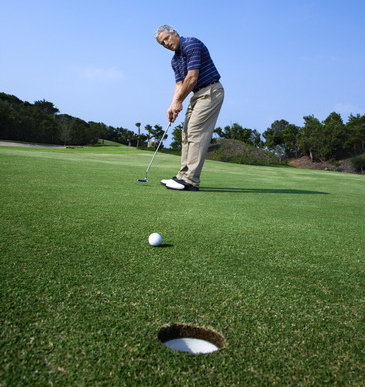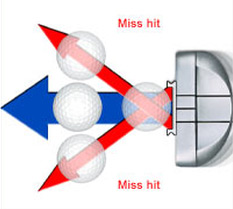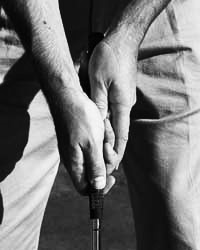In this section we move on to the shortgame and take a closer look at putting.
Considered by many as a game of its own in the game of golf, putting must be mastered just like the long game to play good golf.
Most golfers train their putting by putting several golf balls from hole to hole on the practice tee.
This is a good exercise for beginners if you focus on making each hole with a maximum of two putts.
Nevertheless this exercise won’t help you very much once you have reached a specific skill level.
For best chances of making a putt there are six important factors which can be trained individually:
- reading the putt
- aiming / aligning the putter
- hitting with the sweetspot of the putter
- club face angle
- swing path
- acceleration and speed (the stroke)
Reading the Putt

[clearboth] To read the putt is always the first step thus – making it the first part of putting well.
Most golfers underestimate the break of a putt. “Break” can refer to the amount the path of the putted ball curves, or to the amount the green itself curves or slopes.
If the putting surface is perfectly flat, the ball will roll straight. If there are any contours to green, the ball will break away from the straight line.
To get a good understanding of how to read a putt properly I recommend Dave Pelz’s Putting Bible: The Complete Guide to Mastering the Green.
To get started make it a habit to really examine the green before each putt. Don’t just putt away. This way you’ll learn the most about how the ball behaves with different slopes.
- [clearboth]
Aiming / Aligning the Putter


[clearboth] After you’ve determined the initial direction you want to putt to you still have to align your putter square to your aim line.
If you want to learn how to aim correctly a laser putter is the best tool.
It’s a normal putter with a laser pointer attached to the putter.
This way you can check where you are aiming at and work on your alignment. Another method would be to build an aiming triangle out of cardboard to check where you are aiming at.
[clearboth]
Hitting with the Sweetspot of the Putter


[clearboth]
To hit the ball with the sweetspot of the putter is the single most important factor at impact of putting.
If you miss the sweetspot by 0.12 Inches your golf ball will roll 5 percent shorter. If you miss it by 0,2 Inches the ball will only roll 75 percent of its optimal length.
If you hit the sweetspot the putter won’t turn at impact which leads to an optimal transfer of energy.
To work on your sweetspot you can use putting-clips.
These U-shaped clips make sure that only perfectly hit putts roll straight. The rest will be deflected in an 45 degree angle.
[clearboth]
Club Face Angle at Impact

The club face must be square at impact as well.
You want it to point exactly at the point you are aiming for at impact. Twisting the clubface influences the starting direction of the golf ball by 80 percent.
To work on your club face angle during impact you can use two golf balls. Place them with the exact same distance in front of your putter.
If you hit them square with your putt they will roll with the same speed next to each other.
If you twisted the club head before impact one ball will be faster than the other.
[clearboth]
Swing Path
The swing path of the putter influences the starting direction of the ball by 20 percent with each putt.
There are three possible directions. The putter can be moved exactly along the target line which would be optimal.
It can be moved left of the target line which is most common and it can be moved right of the target line.
[clearboth]
Acceleration and Speed (stroke)
[clearboth] Many golfers struggle with putting the proper distance.
When the ball doesn’t reach the golf hole he most often thinks that he did not putt hard enough.
That mustn’t be the case. If you don’t hit the golf ball with the sweetspot of the putter it won’t roll the full distance although you may have used the proper speed.
Unfortunately you can’t check this after the putt.A good way to work on this are putting clips as already mentioned.
[clearboth]
Grip

With a putt the golf ball usually has to go accurate but not very far.
That’s why it’s best to keep your wrists passive.
To keep your wrists quiet a grip where the hands are parallel to each other is recommended.
Both of your thumbs should be on the front of the club pointing towards the club head.
A puttergrip is usually flattened on the front to make that easier.
[clearboth]
Posture

A putter has the steepest lie of all golf clubs. It allows you to stand so close to the ball that you can place your eyes level above the aim line, which you should do.
You should also position your feet and body parallel to your target line. This way you can look at your target and aim the easiest.
The clubhead of your putter should be parallel to the ground. Because the ball doesn’t have to go up in the air or get very far you don’t need to use your lower body or your wrists.
In fact you should swing only with your arms and shoulders for maximum precision. Think about keeping your head still and rocking a baby.
[clearboth]
Dont forget that virtually every golf hole you will ever play ends with a putt.
If you work on your putting and eliminate those three putts you are well on your way to a good short game.
In the next part we’ll take a look at chipping, pitching and bunkershots:
